When you go on your Roman holiday, the presence of a beautiful fountain at every notable point in the city will surely pique your curiosity. Rome has fountains… an incredible number of them and most of them feature work by prominent artists and sculptors. The ancient Romans believed that water was a gift from Gods and every source of H2O had its own reigning God/ Nymph. A pillar of health, hygiene and life… water is the major element of the Roman society; one only has to look at the amount of socialising going on in the Roman baths to see how important water was to them.
The Lazio region of Italy had an abundance of water (about 38 million gallons was received each day). Water flowed to the city from its surrounding 7 hills (Capitoline, Quirinal, Viminal, Esquiline, Caelian, Palatine and Aventine) by simple gravity and it could be contained in large cisterns. Water flowed from cisterns through pipes to each house and to public distribution points like fountains.
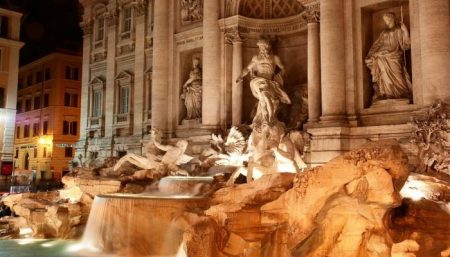
The Roman fountains of yore were not merely decorative pieces nor simple watering holes; they were symbols of aesthetic supremacy, wealth and power. Establishing a fountain meant establishing control over the water supply of a particular region, and decorating the fountain with pillars, backdrop, sculpture etc. was the chance to display one’s wealth and aesthetic sense. Most of the Roman fountains were commissioned by Popes and this water channelled through the city’s profusion of aqueducts became a source of power and control of the Roman church.
Triton Fountain
It’s easy to observe the family crests of many popes branded over fountains and a good place to observe it is the Fontana della Tritone. Piazza Barberini has the lovely Fontana del Tritone (dates back to 1643) that was created by Bernini junior; it shows 4 large dolphins surrounding Triton who blows water out of a conch shell. The palazzo Barberini was owned by Pope Urban VII’s family….note the tiara and the keys imagery in the sculpture.
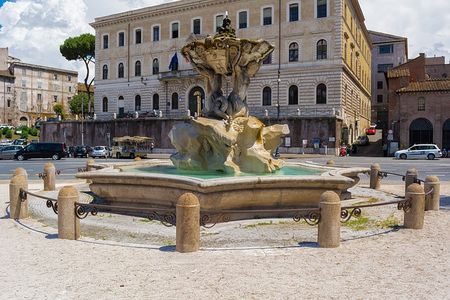
History says that Ovid’s metamorphosis was one of the inspirations behind the fountain… there is a story there that says that Triton (Neptune’s son) blew on a sea horn to end the flood. Unfortunately Pope Urban VII soon died after the Fontana del Tritone was unveiled so he wasn’t able to enjoy the appreciation that this fountain gathered. Like the Trevi fountain, throwing a coin over one’s shoulder in the fountain is also believed to bring on a return visit to Rome.
Fountain Of The Bees
Lying in the shadow of the famous Tritone fountain… just a little way of from Piazza Spagna is a pretty little fountain in Via Veneto; the Fontana delle Api/ Fountain of the bees. The small fountain is decorated with aesthetic sculptures of bees; a symbol of illustrious Barberini family. This sculpture is the yet another work of Lorenzo Bernini and was unveiled around 1644. Look out for the carved shell bearing an inscription dedicated to Pope Urban VII.
Sunken Boat Fountain
At the centre of the happening Piazza di Spagna (right at the bottom of the Spanish steps) lies the Fontana della Baracaccia/ Sunken Boat Fountain with an unusual and rather dramatic sunken boat shape. History says that a distraught boat came floating up to the square when the Tiber was flooded in 1598 and hence the inspiration for this piece. Pope Urban VIII Barberini commissioned the father-son duo sculptors Pietro and Gian Lorenzo Bernini to create this beautiful fountain in this historic area.
Read more about the legendary Spanish Steps.
Trevi Fountain
Of course, the celebrated Trevi fountain makes it to the top of the list of every fountain seeker in Rome. The work of a lot of artists has gone into creating this sculpture masterpiece and city icon though the principal recognitions go to Bernini, Nicolas Sallvi and Giuseppe Pannini. The huge statue of Oceanus with his shell shaped chariot and two Triton horses is eye catching but it sometimes gets difficult to get a proper look at the Trevi. The masses of tourists either throwing coins inside or taking pictures can mar the entire experience.
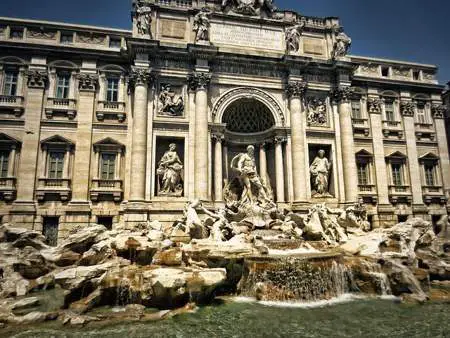
Read our detailed Trevi fountain article to know it better.
Water Nymphs
The Fountain of the Water Nymphs/ Fontanna delle Naiadi is undoubtedly one of the most sensual fountains in the city. The lovely nude nymphs featured on the fountain created quite a buzz in ancient Rome when the famous architect Mario Rutelli unveiled it in 1901. The beautiful nymphs surround a fisherman who is wrestling with a fish. The man is Glaucus who was born a mortal but then turned immortal when he swallowed a miraculous herb.
The Piazza della Repubblica / square is one of Rome’s busiest and the presence of the four naiads or the languorous female spirits who hover over springs, lakes and brooks raised quite a few eyebrows in those times. The four naiads pose with 4 different monstrous aquatic creatures at 4 corners of the fountain. Right now this remains one of the most photographed fountains in Rome.
Neptune Fountain
When you visit the Pantheon in Rome, take a short walk to the intriguing Piazza Navona that boasts of 3 unique fountains. Start off by viewing the splendid but relatively unexplored Neptune Fountain. This one stands at the north end of the square and was originally called Fontana dei Calderari (due to the blacksmith shops located on the street near the fountain).
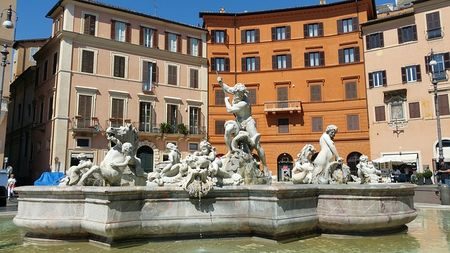
This was one of those rare utility based fountains that didn’t have any statues. However a rather striking statue of Neptune battling an octopus was added by Antonio della Bitta in 1878. The fact that this hugely popular Navona piazza stands atop an old ruined stadium (Domitian) adds to its charms.
Fountain Of The Moor
On the southern end of the square there is Fontana del Moro or the Fountain of the Moor. Designed by Giacomo della Porta in 1575 this fountain had 4 tritons and a large dolphin but the eye catching statue of the Moor was added in 1653 by Lorenzo Bernini. Incidentally the statues in the fountains that you can see now are all replicas; the originals are displayed in the exquisite Galleria Borghese.
Four Rivers Fountain
Most Romans will agree on the fact that the Four Rivers Fountain/ Fontana dei Quattro Fiumi (the most famous fountain on the Piazza Navona) is as spectacular (if not more) than the Trevi. The fountain represents the might of water via the four mighty rivers that have ruled their respective continents. There is Danube (rules Europe), Ganges (rules Asia), Nile (rules Africa) and Rio della Plata (rules Americas); all of them are created by different sculptors giving this sculpture amazing versatility. The fountain graced the centre of the Dominitian stadium and though the stadium has now crumbled, the fame of the fountain remains undiminished.
The Fountain of the Four Rivers was commissioned in 1651 by Pope Innocent X; a logical move as his family palace (Palazzo Pamphiij) looked towards the Piazza. Though the fountain is known as Bernini’s creation different co sculptors worked on different rivers. Claude Poussin co created Ganges, Antonio Lombardo co created Danube, Giacomo Fancelli co created Nile and Francesco Baratta co created Rio Plata. Look out for the intelligent representation of the 5 elements in the fountain; a couple of fishes represent water, a chunk of rocks and plants represent earth. A swaying palm tree represents air and an obelisk represents fire/ sun.
There are other delightful connotations of the sculpture; for example the figure representing Rio is shown holding an arm up in submission (reference to the colonisation of Americas). The pile of coins near Rio de Plata symbolises new money. Look at the figure representing Nile… his face is veiled as the origin of this river was unknown. The Ganges was widely regarded to be the cradle of earliest civilizations and hence the figure has a beard and is sitting near an elephant (symbolic of Asia). Also examine the central obelisk placed at the very top carefully and you will see a bronze dove and olive branch (symbols of Pamphij family) and symbolic of the power Christianity had on all 4 parts of the world.
Quattro Fontane
If you have little time to spare and yet want to see a lot of Roman fountains then head off to the junction between Via del Quirinale and Via delle Quattro Fontane where there is an assorted group of 4 fountains collectively called the Quattro Fontane. All of them were commissioned by Pope Sixtus V and built at the wishes of Muzio Mattei; the installation happened between the years 1588 and 1593. One of the fountains represent the river Tiber in front of a flowing river and a she wolf that’s the symbol of Rome.
Another fountain represents the River Aniene that’s a tributary of Tiber. There are other two fountains nearby that symbolise the Goddess Diana (symbolic of chastity) and Goddess Juno (symbolic of strength). The Aniene, Juno and Tiber fountains were all the creations of Domenico Fontana while the Diana fountain was created by Pietro Cortona. The Baroque church of San Carlo alle Quattro Fontane is also nearby and it’s named after the fountains.
Fountain of the Turtles
The Fountain of the Turtles/ Fontana della Tartarughe is a little removed from the usual tourist circuit and hence you are likely to miss a visit if you don’t know about its lovely sculpture. This one lies in the heart of the Jewish Ghetto in Piazza Mattei and is an ode to the powerful and illustrious Mattei family who reigned in Rome in the renaissance period.
This was designed in the 16th century by Giacomo della Porta ….incidentally the creator of 2 other fountains in Piazza Navona… this particular fountain is very elegant with its group of marble and bronze rafted youths who stand atop a group of conch shells and dolphins and encourage little turtles to enter the basin above.
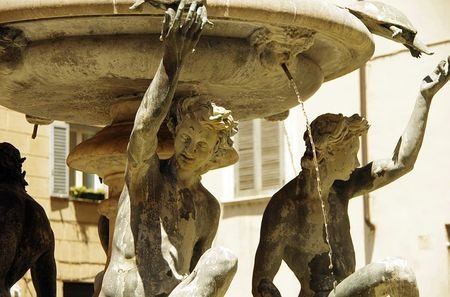
The Turtle fountain was once used as the water supplier of the entire neighbourhood and since it was funded by the Mattei family it was placed near their Villa. Incidentally the position was right outside the ghetto walls making it hazardous for Roman Jews to pick up water from here after the gates were closed at night. Interestingly, though the fountain was created around 1580 by Della Porta the delightful turtles were added around 100 years later by Bernini. There is a delightful little church nearby and its chiming bells creates a pleasant backdrop for the music of water here.
Fontanone del Gianicolo
If treating your eyes to a magnificent view appeals to you then immerse yourself in the experience of visiting on Gianicolo hill. On top of the hill there is a very large fountain flanking Porta San Pancrazio… it’s called Fontanone dell Acqua Paola or Fontanone del Gianicolo. Built in 1612 and commissioned by Pope Paul V who wanted to outshine his predecessors who built the Fontana dell Acqua Felice. Building the fountain came as a natural course of action after the Traiano aqueduct was repaired (this was built in 107 BC) and re-enabling it to carry water from Lake Bracciano that’s 47 km away.
However its ostentatious marble baroque background of 6 columns (2 grey granite and 4 red granite) along with 5 arches is clearly an attempt to impress. The façade has lots of angels and dragons though the fountain design is kept simple… water spills out from 3 bowls into a large semi-circular basin. The marble and most of the construction material was scavenged from old ruins as was the custom. Today the Fontannone as it’s fondly referred to by the locals is considered to be one of the most romantic spots in Rome.
A designer called Giovanni Fontana (nice coincidence isn’t it) built the fountain and sometimes it’s also called the Il Fontanone or the Big Fountain. Pope Paul V certainly outdid his competitor’s creation at least in terms of size and scale. Some special tours allow visitors to step inside the fountain and sipping some cool Prosecco while dipping your toes inside the fountain can be a one of a kind experience.
Other Fountains
While on the subject of fountains it’s hard to ignore the Piazza del Popolo that’s near the Borghese Park. The ancient obelisk is surely the major attraction here… it was brought here from Heliopolis Egypt in the times of antiquity. 3 churches border the square and the fountains here are skilfully integrated into the walls of the Piazza too give it an aesthetically refined appearance.
The fountain at the west end of the square is Fontana del Nettuno / Neptune fountain and it shows Neptune flanked by 3 Tritons. Right opposite the Neptune fountain at the foot of the Pincio Gardens is the Fontana della dea di Roma or the fountain of Goddess of Rome. The central figure is the stately Goddess of Rome who is flanked by two figures (Rivers Aniene and Tiber). Right at the foot of the Goddess is a she wolf suckling Remus. While you are here don’t miss the magnificent Santa Maria del Popolo and the symmetrical churches Santa Maria dei Miracoli and the Santa Maria in Montesanta.
Visiting the fountains of Rome can be done as a pleasant cultural walk as you choose the number and kinds of fountains you want to visit based on their location and your other sightseeing plans. While the larger and grander fountains like Trevi, Four Rivers fountains etc. are teeming over with tourists busy in throwing coins and taking umpteen selfies, it’s the smaller yet equally lovely fountains that define Rome’s true character.
You will see locals gathering around the fountains allowing its sweet sprays to tone down the effect of the scorching Roman sun. People sit and gossip in benches that usually flank the fountains and kids play around the square. Humans and birds alike quench their thirst from the still drinkable water of these fountains and some fill up their bottles. On so many levels, Rome’s fountains have continued to be what they were meant to be… social gathering hotspots and the essence of Roma.
 A travel addict. Still celebrating the day when he quit his high-profile corporate job to pursue his passion for travel writing.
A travel addict. Still celebrating the day when he quit his high-profile corporate job to pursue his passion for travel writing.